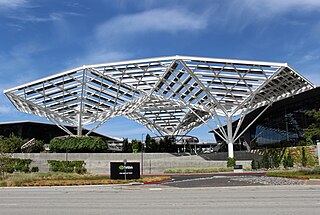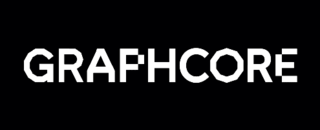Related Research Articles

Nvidia Corporation is an American multinational corporation and technology company headquartered in Santa Clara, California, and incorporated in Delaware. It is a software and fabless company which designs and supplies graphics processing units (GPUs), application programming interfaces (APIs) for data science and high-performance computing as well as system on a chip units (SoCs) for the mobile computing and automotive market. Nvidia is also a dominant supplier of artificial intelligence (AI) hardware and software.

A graphics processing unit (GPU) is a specialized electronic circuit initially designed to accelerate computer graphics and image processing. After their initial design, GPUs were found to be useful for non-graphic calculations involving embarrassingly parallel problems due to their parallel structure. Other non-graphical uses include the training of neural networks and cryptocurrency mining.
The transistor count is the number of transistors in an electronic device. It is the most common measure of integrated circuit complexity. The rate at which MOS transistor counts have increased generally follows Moore's law, which observes that transistor count doubles approximately every two years. However, being directly proportional to the area of a die, transistor count does not represent how advanced the corresponding manufacturing technology is. A better indication of this is transistor density which is the ratio of a semiconductor's transistor count to its die area.

Tegra is a system on a chip (SoC) series developed by Nvidia for mobile devices such as smartphones, personal digital assistants, and mobile Internet devices. The Tegra integrates an ARM architecture central processing unit (CPU), graphics processing unit (GPU), northbridge, southbridge, and memory controller onto one package. Early Tegra SoCs are designed as efficient multimedia processors. The Tegra-line evolved to emphasize performance for gaming and machine learning applications without sacrificing power efficiency, before taking a drastic shift in direction towards platforms that provide vehicular automation with the applied "Nvidia Drive" brand name on reference boards and its semiconductors; and with the "Nvidia Jetson" brand name for boards adequate for AI applications within e.g. robots or drones, and for various smart high level automation purposes.

Massimiliano Versace is the co-founder and the CEO of Neurala Inc, a Boston-based company building Artificial Intelligence emulating brain function in software and used in automating the process of visual inspection in manufacturing. He is also the founding Director of the Boston University Neuromorphics Lab. Massimiliano Versace is a Fulbright scholar and holds two PhD in Experimental Psychology from the University of Trieste, Italy and Cognitive and Neural Systems from Boston University, USA. He obtained his BSc from the University of Trieste, Italy.

Tsubame is a series of supercomputers that operates at the GSIC Center at the Tokyo Institute of Technology in Japan, designed by Satoshi Matsuoka.

Volta is the codename, but not the trademark, for a GPU microarchitecture developed by Nvidia, succeeding Pascal. It was first announced on a roadmap in March 2013, although the first product was not announced until May 2017. The architecture is named after 18th–19th century Italian chemist and physicist Alessandro Volta. It was Nvidia's first chip to feature Tensor Cores, specially designed cores that have superior deep learning performance over regular CUDA cores. The architecture is produced with TSMC's 12 nm FinFET process. The Ampere microarchitecture is the successor to Volta.
Kinetica is a distributed, memory-first OLAP database developed by Kinetica DB, Inc. Kinetica is designed to use GPUs and modern vector processors to improve performance on complex queries across large volumes of real-time data. Kinetica is well suited for analytics on streaming geospatial and temporal data.

Daniel Gross is an American entrepreneur who co-founded Cue, led artificial intelligence efforts at Apple, served as a partner at Y-Combinator, and is a notable technology investor in companies like Uber, Instacart, Figma, GitHub, Airtable, Rippling, CoreWeave, Character.ai, Perplexity.ai, and others.
An AI accelerator, deep learning processor, or neural processing unit (NPU) is a class of specialized hardware accelerator or computer system designed to accelerate artificial intelligence and machine learning applications, including artificial neural networks and machine vision. Typical applications include algorithms for robotics, Internet of Things, and other data-intensive or sensor-driven tasks. They are often manycore designs and generally focus on low-precision arithmetic, novel dataflow architectures or in-memory computing capability. As of 2024, a typical AI integrated circuit chip contains tens of billions of MOSFETs.
Nervana Systems was an artificial intelligence software company based in San Diego, California, and Palo Alto, California. The company provided a full-stack software-as-a-service platform called Nervana Cloud that enabled businesses to develop custom deep learning software. On August 9, 2016, it was acquired by Intel, for an estimated $408 million.

AMD Instinct is AMD's brand of data center GPUs. It replaced AMD's FirePro S brand in 2016. Compared to the Radeon brand of mainstream consumer/gamer products, the Instinct product line is intended to accelerate deep learning, artificial neural network, and high-performance computing/GPGPU applications.

Graphcore Limited is a British semiconductor company that develops accelerators for AI and machine learning. It has introduced a massively parallel Intelligence Processing Unit (IPU) that holds the complete machine learning model inside the processor.

Insilico Medicine is a biotechnology company based in Pak Shek Kok, Hong Kong in Hong Kong Science Park near the Chinese University of Hong Kong, and in New York, at The Cure by Deerfield. The company combines genomics, big data analysis, and deep learning for in silico drug discovery.
aiMotive is an autonomous vehicle technology company. The company aims to work with automotive manufacturers and Tier1s to enable automated technologies. aiMotive describes its approach as "vision-first", a system that primarily relies on cameras and artificial intelligence to detect its surroundings. The technology is designed to be implemented by automobile manufacturers to create autonomous vehicles, which can operate in all conditions and locations. In September 2017, PSA Group teamed up with AImotive.
Deep technology or hard tech is a classification of organization, or more typically startup company, with the expressed objective of providing technology solutions based on substantial scientific or engineering challenges. They present challenges requiring lengthy research and development, and large capital investment before successful commercialization. Their primary risk is technical risk, while market risk is often significantly lower due to the clear potential value of the solution to society. The underlying scientific or engineering problems being solved by deep tech and hard tech companies generate valuable intellectual property and are hard to reproduce.

The Persistence of Chaos is a work of art consisting of a laptop that contains six computer viruses, worms, and pieces of malware that have caused major damage. The artwork was created in 2019 by artist Guo O Dong and the collective MSCHF, and sold at auction for $1,345,000 in May 2019. Guo O Dong described it as a bestiary for historical malware, and expressed concern about the high price for which it sold, stating that he would either spend the money on another project or burn it.
Huang's law is an observation in computer science and engineering that advancements in graphics processing units (GPUs) are growing at a rate much faster than with traditional central processing units (CPUs). The observation is in contrast to Moore's law that predicted the number of transistors in a dense integrated circuit (IC) doubles about every two years. Huang's law states that the performance of GPUs will more than double every two years. The hypothesis is subject to questions about its validity.
Nvidia GTC is a global artificial intelligence (AI) conference for developers that brings together developers, engineers, researchers, inventors, and IT professionals. Topics focus on AI, computer graphics, data science, machine learning and autonomous machines. Each conference begins with a keynote from Nvidia CEO and founder Jensen Huang, followed by a variety of sessions and talks with experts from around the world.
Specialized computer hardware is often used to execute artificial intelligence (AI) programs faster, and with less energy, such as Lisp machines, neuromorphic engineering, event cameras, and physical neural networks. As of 2023, the market for AI hardware is dominated by GPUs.
References
- ↑ Musthaler, Linda. "How to use deep learning AI to detect and prevent malware and APTs in real-time". Network World. Retrieved 2017-12-19.
- ↑ "Can Deep Learning Take Cybersecurity To The Next Level? This Startup Says Yes". Fast Company. 2016-09-09. Retrieved 2017-12-19.
- ↑ "11 Israeli Cybersecurity Firms That Left Their Mark On 2017". NoCamels - Israeli Innovation News. 2017-11-16. Retrieved 2017-12-19.
- ↑ Crawford, Tim (2017-10-18). "Leveraging Artificial Intelligence & GPUs for Cybersecurity". gigaom.com. Archived from the original on 2017-12-22. Retrieved 2017-12-19.
- ↑ "The Business of Artificial Intelligence". Harvard Business Review. 2017-07-18. Retrieved 2017-12-19.
- ↑ "Soon, your most important security expert won't be a person" . Retrieved 2017-12-19.
- ↑ "Introducing the Technology Pioneers 2017". weforum.org. Retrieved 9 September 2020.
- ↑ "Deep Instinct". Start-Up Nation Finder. Retrieved 9 September 2020.
- ↑ "NVIDIA Invests in Cybersecurity Startup Deep Instinct". NVIDIA. 2017-07-12. Retrieved 2019-06-14.[ self-published source ]
- ↑ Armasu, Lucian Armasu. "Nvidia Invests In Deep Instinct, A Deep Learning-Based Cybersecurity Startup". Tom's Hardware. Retrieved 4 September 2020.
- ↑ Lunden, Ingrid. "Deep Instinct nabs $43M for a deep-learning cybersecurity solution that can suss an attack before it happens". TechCrunch. Retrieved 9 September 2020.
- ↑ "The Persistence of Chaos, 2019". artist, Guo O Dong. 2019-04-15. Retrieved 2019-06-14.
- ↑ "HP teams with Deep Instinct on cybersecurity". Globes. 28 May 2019. Retrieved 9 September 2020.
- ↑ "Deep Instinct Closes $100 Million Series D New Funding to Fuel Hyper-Growth". Deep Instinct. 22 April 2021. Retrieved 8 December 2021.